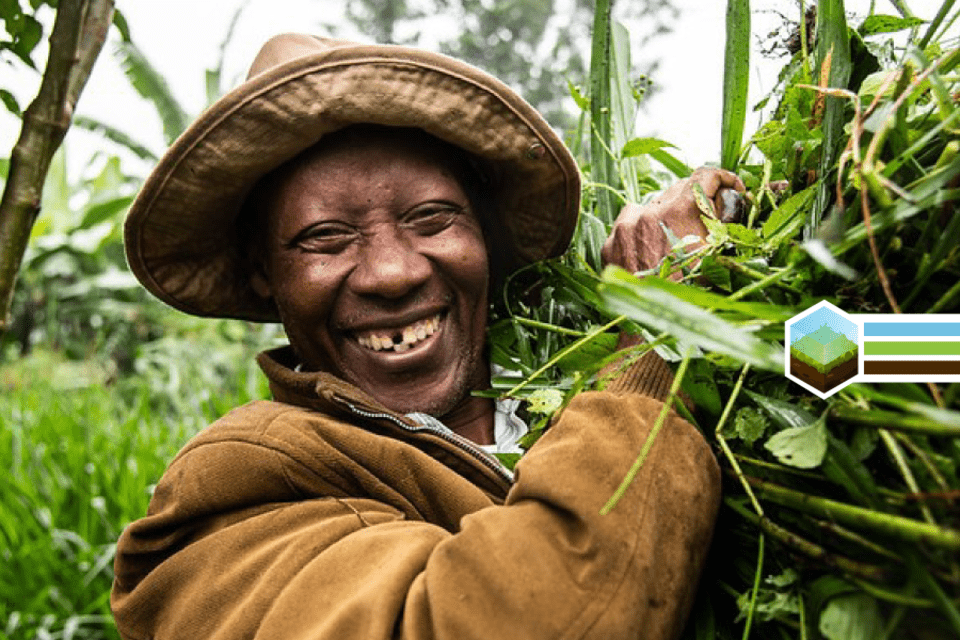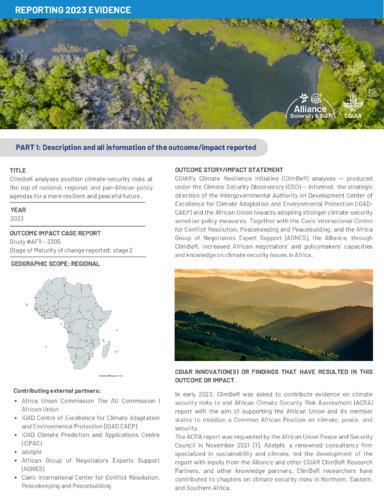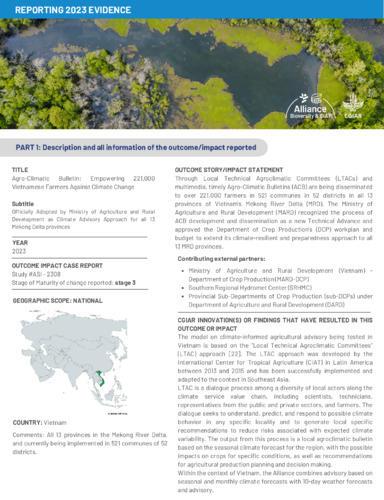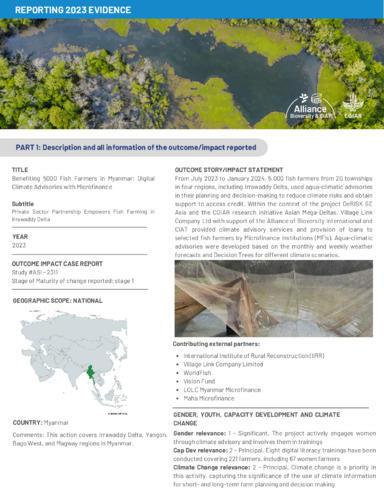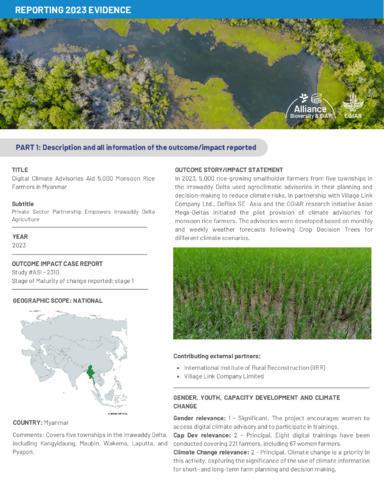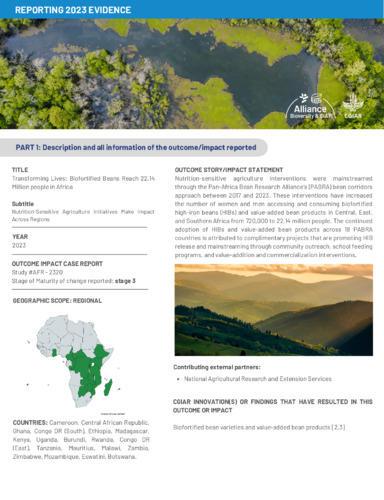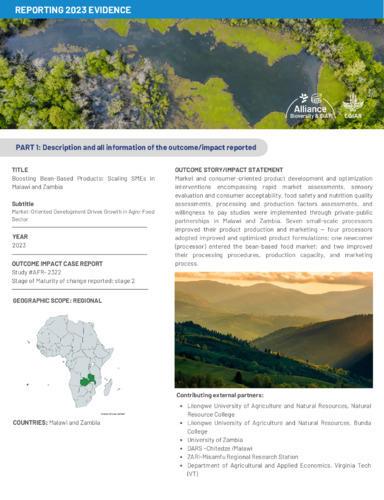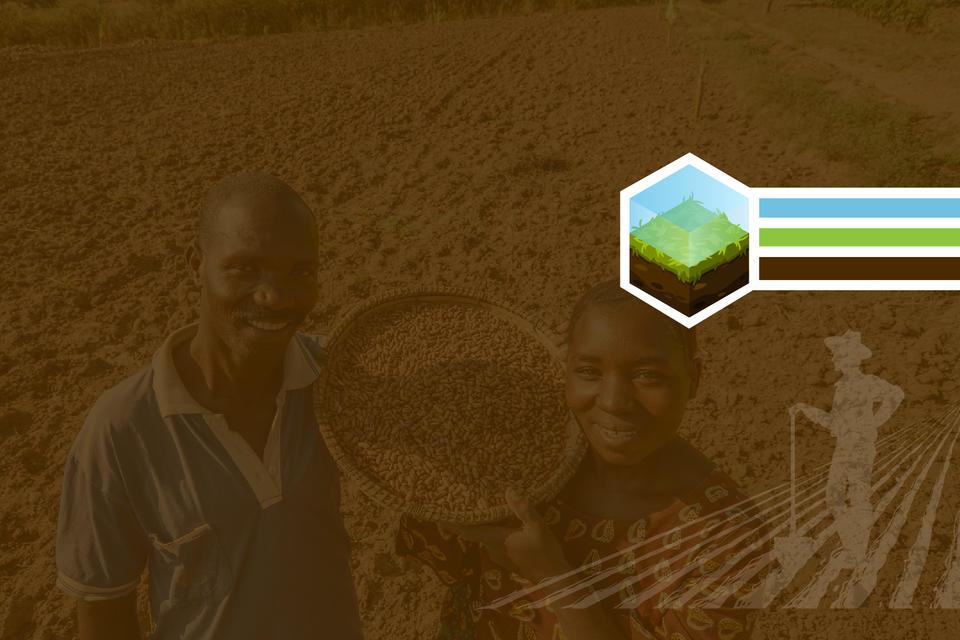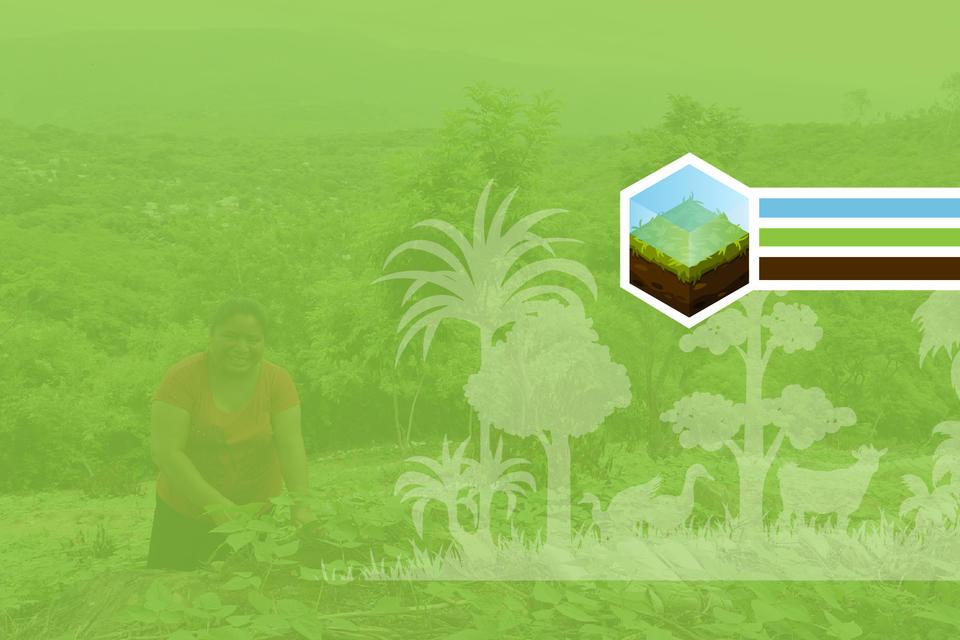2023 Annual report Enhancing Resilience Through Climate Action

With the impacts of climate change on food systems increasingly visible, strengthening resilience across value chains requires innovations that allow producers to thrive even in the face of climate variability. In 2023, the Alliance’s work increased climate resilience on multiple scales: providing timely information to smallholder farmers, linking entrepreneurs to climate-smart agriculture and better business models, changing how we breed crops, and influencing highest-level policy and decision making.
Resilience on the ground: Listening to Ethiopian pastoralists
In Ethiopia’s Oromia region, pastoralists have depended on rainfall for centuries, sustaining their livestock despite harsh dry conditions. However, for four consecutive seasons, the rain has failed them. “Today it is impossible, because everything has dried out everywhere we went,” one farmer reported to our researchers.
For our team in Ethiopia, understanding climate-induced risks such as the increasingly severe and frequent droughts, is the first step towards building climate resilience. Working closely with pastoralists and policymakers, we were able to identify communities’ needs: real-time information, early warning systems, and communication in local languages. Once the needs were identified, the next task has been to choose the right resources to address them: maps, tools, etc. Once the supportive materials are developed, the next task is upscaling.

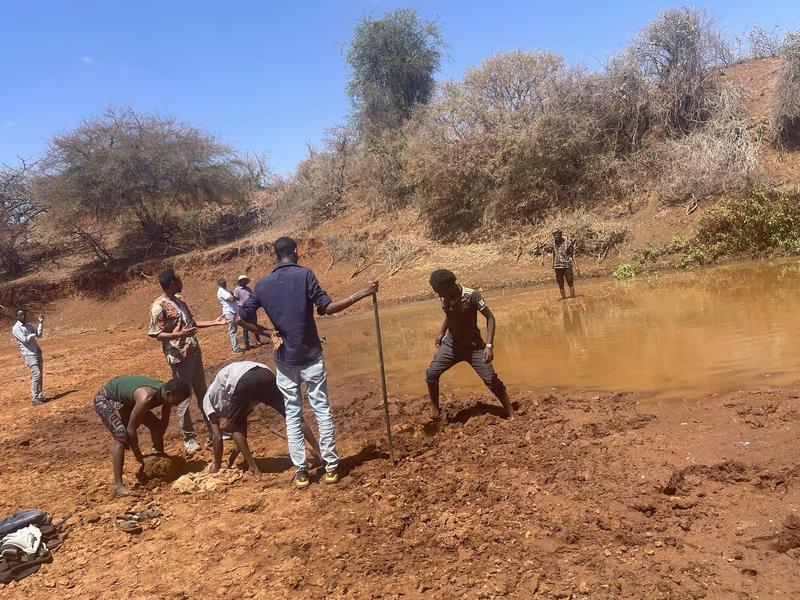
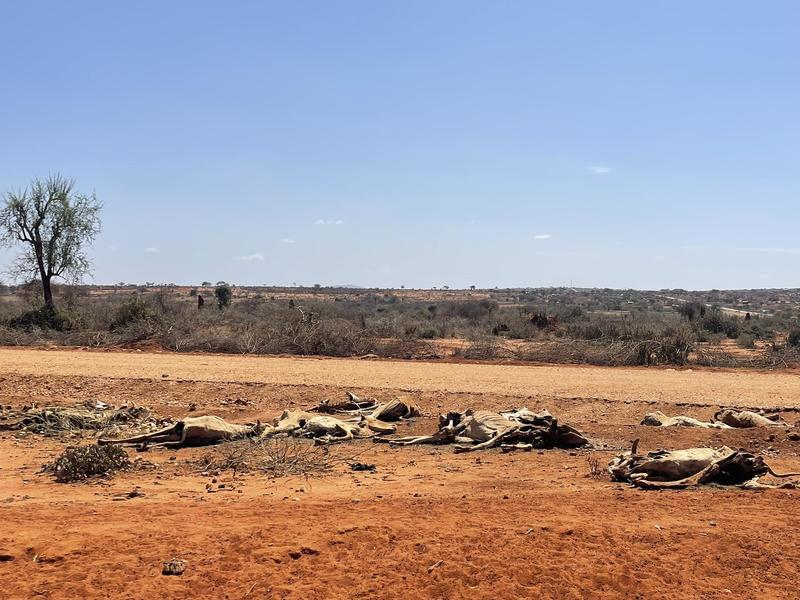
Empowering Farmers With Climate-smart Agriculture
Building on the legacy of the CGIAR Research Program on Climate Change, Agriculture and Food Security (CCAFS), joint research initiatives led by the Alliance of Bioversity and CIAT provided opportunities to visibly enhance farmers’ resilience on the ground.
One example is our leadership of the Accelerating Impacts of CGIAR Climate Research for Africa (AICCRA) project, which in 2023 reached more than 4 million farmers. Drawing together expertise from 11 CGIAR research centers and 82 partner organizations, AICCRA increased smallholder farmers’ access to climate information services, delivering climate-smart agricultural innovations that increased farming communities’ resilience to growing challenges. Together, these innovations inform farmers' short- and long-term decisions, supporting them in developing practices that maintain yields even in the face of changing climates.

Ana Maria Loboguerrero
Director, Climate ActionCase Study: Women Entrepreneurs
The Gender-Smart Accelerator Challenge in Senegal, led by the Alliance and its partners, addresses the constraints faced by women entrepreneurs by de-risking investment in innovative, climate-smart agricultural small- and medium-sized enterprises in the country, where women's entrepreneurship is an untapped source of job creation, economic growth and empowerment.
Hermione Awounou runs a family business called ‘Arachide et Cajou du Sénégal’ where 80% of the employees are women. The company specializes in snacks made with cashew nuts, peanuts, potatoes, and other products from small-scale producers; the business recently received a significant upscaling investment from USAID.
"Thanks to this program, we’re received many opportunities. After four months of coaching and mentoring, our business is better structured, and we are well equipped to seek funding.” Hermione Awounou, CEO of Arachide et Cajou du Sénégal
Putting climate on the curriculum
Capacity building and education are essential for increasing climate resilience. Implementation of the ‘Climate Risk Management in Agricultural Extension’ training program in several African countries was the first of its kind: a collaborative effort between multiple partners that is now carried out by 70 national institutions across Africa, representing multiple public and private farming advisory providers. In 2023, the Alliance partnered with multiple universities to incorporate thought-provoking and practical modules into students’ curriculum, covering topics such as Climate, Peace and Security in Agriculture.
At the Alliance, we’ve also contributed to smallholder farmers’ climate and financial literacy, integrating climate risk assessments into financial instruments, improving credit and insurance products for smallholder farmers. For example, our climate-credit risk scoring tool is already having a positive impact on the resilience of dairy farmers in Kenya.
Tracking our Impact: Higher-education courses on climate-smart agriculture and climate information services, reaching over 1,500 university lecturers.
Climate Security
Climate hazards and scarce resources are exacerbating the root causes of conflict, fragility, displacement and forced migration; meanwhile, ongoing conflicts are also blocking efforts to increase climate resilience, making the climate-security nexus an important consideration. In 2023, we developed valuable tools through our flagship Climate Security Observatory, the CGIAR Climate Resilience initiative and multiple publications that shed light on this topic (e.g. 1,2,3,4,5,6,7,8,9). The outputs of this work reached global policymakers through multiple dissemination activities: notably, the historic address of Alliance researcher Sandra Kadry to the United Nations Security Council.
Influencing high-level policy, we participated in the United Nations’ COP28, through an $8.5 million USD endorsement of the COP Presidency’s Declaration on Climate, Relief, Recovery and Peace; informed continental and regional climate strategies (AU - African Climate Security Risk Assessment, IGAD-CAEP Regional Adaptation Strategy); increased the capacity of hundreds of African policymakers working on the climate, peace, conflict, and displacement nexus; forged a partnership with UNHCR within the CGIAR Fragility Initiative, thus supporting the agency’s protection of 110 million displaced people; and potentially influenced policy in 135 countries, strengthening climate resilience for and with those who need it most (read about it here).
Tracking our impact: Climate Security Observatory informs climate-security policy measures

Grazia Pacillo
Senior Scientist and Co-lead of CGIAR FOCUS Climate Security
Peter Laderach
Co-lead CGIAR FOCUS Climate SecurityClimate Services
For farmers, both short-term weather fluctuations and long-term changes in climate trends have serious implications. To make decisions on what crops to plant, when to do so, etc., farmers need access to more (and more accurate) predictions than ever before. Climate information services aim to address this by providing specific and timely predictions stretching from short-term weather forecasts to predictions of seasonal and long-term climate patterns.
A successful example of offering climate information services in 2023 is the development of agro-climatic bulletins in Vietnam, which are now used in 13 provinces of the Mekong River Delta, supporting 221,000 farmers to manage climate risks. The bulletins are disseminated mainly through Zalo – Vietnam’s most popular messaging app – and offer weather and climate predictions that inform farmers’ decision making about crop varieties, planting and harvesting dates, and irrigation needs, as well as optimal application of fertilizers and pesticides.
The bulletins use the ‘Local Technical Agroclimatic Committees’ approach, first developed by the Alliance in Latin America a decade ago, highlighting possible climate risks in specific localities, and offering tailored recommendations to face these. With government support, there is huge potential to upscale the bulletins across Vietnam to improve national agricultural productivity and resilience to climate change.
In 2023, for the first time, thousands of fish farmers in Myanmar’s Irrawaddy Delta are benefitting from climate advisory services tailored to their needs. This is thanks to an innovative public-private partnership in which the Alliance’s provision of AccuWeather forecasts and other data is merged with Village Link Company Ltd’s understanding of aquaculture sector needs, resulting in advisory services disseminated to farmers through apps and social media. The services are improving farmers’ access to formal credit, enabling them to reduce their reliance on informal sources of financing with high interest rates.
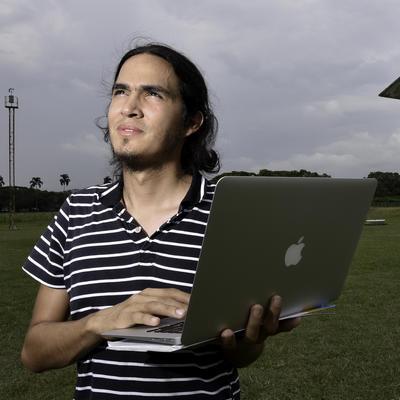
Julian Ramirez-Villegas
Principal Scientist on Climate Impacts
Cornelis (Kees) Swaans
Senior ScientistCrop Breeding for Resilience and Sustainability
Climate change can significantly stress crops, influencing their growth and health. Take the example of rice: a basic source of nutrition for over 3.5 billion people, growth of this daily staple is heavily affected by higher night-time temperatures (already an additional 2 degree Celsius). Higher temperatures also accelerate the spread of diseases, especially in tropical conditions.
At the Alliance, one of our priorities is to enhance ‘stress tolerance’, while actively breeding varieties with improved performance. What does this look like in practice? In the case of rice, by analyzing diverse cultivars, we can select genes with characteristics such as improved productivity and root quality, using these to breed varieties that maintain current yields while lowering overall greenhouse gas emissions.
“By adapting crops to climate change, incorporating diverse cropping systems, and promoting soil-friendly practices, we aim to achieve sustainability while enabling farmers to be resilient and prosperous.”
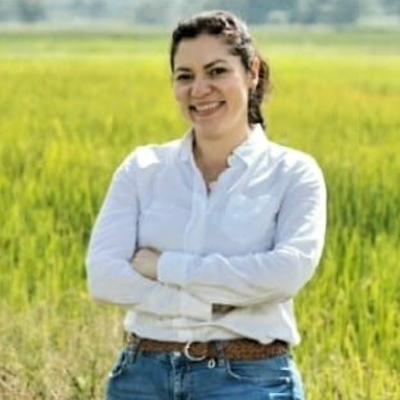
María Fernanda Álvarez
Director, Crops for Nutrition and Health, and Program Leader, Rice Breeding and GeneticsForages for Climate
1. Stress-resilient forages
Livestock farming provides approximately 500 million farmers with income and micronutrient-rich food, which is essential for vulnerable populations. Resilient forage-based livestock systems are needed to meet the increasing demand for animal products due to global population growth, while reducing the areas devoted to grazing. Developing tropical forages resistant to biotic and abiotic stresses is a key component of developing resilient forage-based agricultural systems in the face of climate change.
Improved grasses play a key role in meeting the growing demand for meat and dairy in low- and middle-income countries. The Alliance’s forage breeding aims to develop stress-resilient hybrids with improved productivity and nutritional quality. Modern methods of phenotypic evaluation are used to identify Urochloa and Megathyrsus grasses with tolerance to major pests (spittlebug and spider mite), diseases (Rhizoctonia), low soil quality, drought and waterlogging.
The adoption of improved forages keeps growing: A socioeconomic study conducted in 2023, revealed that Urochloa hybrids have been adopted by > 1.4 million farmers on 1.6 million hectares, and benefitted almost 11 million people in 70 countries. Most of the adoptions happened in Latin America and the Caribbean, but Africa and Asia are emerging markets with large untapped potential for further adoption. A study conducted in 2023 analyzed potential markets for new hybrids of Urochloa and Megathyrsus maximus, adapted to the stressful environments of eastern and western Africa, making progress towards resilient livestock systems in the region.
2. Low-methane forages
Livestock production generates approximately 34% of global agricultural emissions, of which roughly 65% come from the Global South, mostly due to the emission of methane from enteric fermentation. So, how do we reduce methane emissions? Developing nature-based solutions can reduce emissions from livestock feed for countries where most animal production takes place in mixed systems which include grazing.
Tropical forages (legumes, grasses) have great potential to reduce livestock’s methane emissions. Some forages contain compounds that change animals’ digestion process by impacting the composition of gut microbes, which reduce livestock’s methane emissions. CGIAR gene banks conserve the largest forage collections (71,000 seed samples), some of which are considered ‘low methane' because they contain secondary metabolites such as tannins, saponins or flavonoids with anti-methanogenic activity that can reduce methane produced by enteric fermentation.
In 2023, the Low-Methane Forages project has been established by the Alliance in partnership with ILRI, ICARDA, the Bezos Earth Fund, the Bill & Melinda Gates Foundation, and other public- and private-sector partners with a budget of $27 million USD over five years. This long-term effort will align with the Global Methane Hub to complement and build on cutting-edge knowledge and science in feed additives, inhibitors, and innovations in rumen microbiology, decreasing methane emissions while protecting the livelihoods of livestock farmers.

3. Deep rooted forages
Strategic adjusting the soil carbon budget, if only by a few percentage points, represents significant potential for aligning agriculture and climate policy. A recent IPCC assessment indicated that carbon dioxide removal methods such as soil carbon sequestration can improve soil quality and food production capacity while reducing global warming. Research from the Alliance’s Tropical Forages Program has shown the potential of forage cultivars to adapt to acid soils and climate change through improved root systems, as well as contributing to the mitigation of climate change through SOC storage and reduced nitrous oxide (N2O) emissions through biological nitrification inhibition (BNI).
In 2023, the Bezos Earth Fund continued supporting Alliance research on genetic diversity and developing new root ideotypes of tropical forages and rice for improving carbon assimilation via photosynthesis and deep rooting ability that contribute to enhanced carbon storage in tropical soils.
Jacobo Arango
Senior Scientist
Rosa Jauregui
Tropical Forages BreederStefan Burkart
Senior ScientistBeans Mean Resilient Business
Beans are staple food for approximately 400 million people in Africa. As well as providing a basic source of nutrition, many smallholder farmers and traders rely on beans for their incomes, the majority of whom are women. Demand-led research by the Alliance’s Pan-African Bean Research Alliance (PABRA), has made great progress not only on improving and disseminating beans to farmers, but also on transforming people’s perception of beans, from being a mere subsistence crop to a highly valued food.
A major achievement in 2023 was winning the Africa Food Prize, which recognized PABRA’s decades of breeding and disseminating climate-smart and nutrient-rich bean varieties.
Other achievements included the deployment of demand-led research through the bean corridor approach to enhance bean productivity and marketing. For example, in 2023 Uganda’s bean trade with its neighboring countries was valued at $132 million USD (in comparison to $10 million USD in 2010). To tackle climate change and respond to farmers and consumers, PABRA continued developing climate-resilient varieties and facilitating seed access to millions of smallholder farmers. In Kenya, the Alliance worked with farming communities to upscale production of Nyota beans (a climate-resilient variety that takes just 65 days to mature). Farmers who adopted Nyota were able to harvest approximately 1.8 tons/ha despite erratic weather, in comparison to an average of 500 kg/ha with previous varieties. Since Nyota's release in 2017, production has reached 50,000 tons – 8% of Kenya’s annual bean production.
The PABRA model is being applied to other crops through CGIAR Initiatives (‘Accelerated Breeding’ and ‘SeedEqual’). In 2023, a multi-stakeholder project in Nigeria reached 1,200 smallholder farmers (of which 45% are women) with demand-led improved cowpea varieties. Within just two years, the seed partner companies increased the production of the certified cowpea seeds fivefold, increasing from 157 tons to 822 tons.

Jean Claude Rubyogo
Lead, Global Bean Program and Director, Pan Africa Bean Research Alliance (PABRA)Tracking our Impact: Biofortified beans reach 22.14 million people in Africa
Boosting bean-based products: scaling SMEs in Malawi and Zambia
Carbon Sequestration
Did you know that the carbon stored in soil is almost twice the quantity of carbon in the atmosphere and in vegetation combined? In 2023, we made progress enhancing climate resilience through our work on soil health, which acts as both a source and a sink of carbon. Soil characteristics, climate, terrain and inputs are important factors affecting soil organic carbon (SOC) storage. Our 2023 spatial modelling work on SOC in the Colombian flooded savannas has identified land use, topography, and soil texture as the primary drivers of SOC variability. These savanna landscapes hold important SOC stocks (55.07 Mt of C), which may be susceptible to damage from land use change. Strategies to maintain or enhance long-term SOC require integrated and site-specific solutions. As part of our ongoing work supported by Bezos Earth Foundation , we are monitoring field trials to understand the mechanisms behind SOC sequestration in crop-livestock systems and deep-rooted genotypes. Additionally, we are employing digital soil mapping and artificial intelligence to map SOC stocks, identify sequestration hotpots, and propose potential interventions to unlock further SOC sequestration potential.

Mayesse da Silva
Senior Soil Scientist
Louis Verchot
Principal Scientist, Landscape RestorationThe Future for our Climate Research
In 2024, our Climate research teams will continue our work through four flagship areas: Achieving Net-Zero, Climate Security and Migration, Climate Services for Agriculture, and Climate Readiness. We aim to focus closely on policy and financial innovations that mitigate climate risks and reduce emissions, especially for vulnerable communities.



